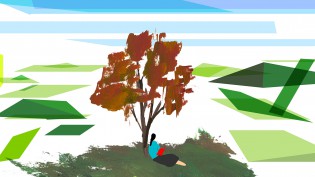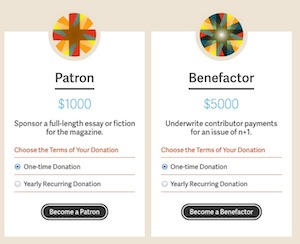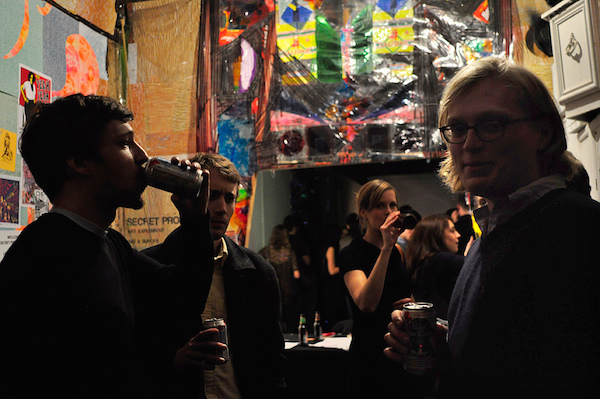
At ten years old, n+1 is no longer a newcomer to the small magazine scene. Carla Blumenkranz, a contributing editor who recently left for a job at The New Yorker, says when the magazine was founded in 2004, a lot of small print journals were closing.
 “Now, there are a lot more — there’s New Inquiry, Jacobin, The Baffler is back. It’s a different field,” she says. “It’s a little strange that n+1 is considered established.”
“Now, there are a lot more — there’s New Inquiry, Jacobin, The Baffler is back. It’s a different field,” she says. “It’s a little strange that n+1 is considered established.”
Like most of its fellow small magazines, n+1’s reputation exceeds its size. Currently, n+1 employs two people full time. The majority of its revenue comes from its 5,500 subscribers, though if you include sales at bookstores and events, total circulation is closer to 10,000. Until very recently, none of the content in the print magazine was available online, but online-only content, published a few times a week, garnered the website around 180,000 views a month. (Editor Dayna Tortorici says that figure is rough, as n+1 only recently switched from StatCounter to Google Analytics.)
“Sometimes we’ll expect a web piece to get the average 7,000 hits, and then it’ll be like 20,000 or something, because it’s really on the pulse and we didn’t even know it,” says Blumenkranz. When that happens, the editors will often append a note welcoming new readers and encouraging them to subscribe. Over time, the magazine’s staff has picked up other digital tricks as well. For example, their content is very popular on Facebook. They’ve also developed a unique trick for making magazine headlines, which can be obtuse, more social media friendly — in the archives, stories are displayed with pre-made, tweet-length excerpts.

Bringing the archives online is the biggest part of the change to come to n+1 of late. Though the site has published free content digitally since its founding, the editors of n+1 — like their counterparts at The New Yorker and Jacobin — thought it was high time that their best content become more available, for subscribers at least.
“For a long time we’ve wanted to bring the magazine online and give online readers a fuller picture of the organization,” Blumenkranz says. “The technology is changing, and it became an easier thing to do.” Coinciding with the magazine’s tenth anniversary and web redesign is the release of an anthology, called Happiness: Ten Years of n+1. Writes Tortorici in an email:
…although they’re made of the same stuff — subscribers can, of course, read the essays that appear in Happiness in the archives online — we never thought of them as being in competition. On the contrary, I think their near-simultaneous unveiling clarifies some things about print vs. digital reading. It’s not so dramatic or scary to do both; only publishers with a stake in one or the other really believe that one thrives at the expense of the other. […] From a publishing perspective, it’s a really exciting experiment.
 Little magazines gone digital: How the late-adapting literary press has made its way in the web agen+1: Learning that print and digital can peacefully coexistJacobin: A Marxist rag run on a lot of petty-bourgeois hustleThe Baffler: The anti-innovation magazine embraces digitalThe New Inquiry: Not another New York literary magazineA conversation with David Rose, little magazine veteran and publisher of Lapham’s QuarterlyMcSweeney’s Meets Internet: A little publisher survives holding tight to its eclectic, literary roots
Little magazines gone digital: How the late-adapting literary press has made its way in the web agen+1: Learning that print and digital can peacefully coexistJacobin: A Marxist rag run on a lot of petty-bourgeois hustleThe Baffler: The anti-innovation magazine embraces digitalThe New Inquiry: Not another New York literary magazineA conversation with David Rose, little magazine veteran and publisher of Lapham’s QuarterlyMcSweeney’s Meets Internet: A little publisher survives holding tight to its eclectic, literary roots“A lot of grant funding these days is going towards individual artists,” she says. “It’s harder than you’d think to get general operating funds for something that’s much more like a collective.”
 So the magazine sells ads and merchandise and books — sometimes as much for fun as for profit, according to the editors. A small advisory council helps the team solicit larger individual donations. (They even rent their office space for parties.) But the real traction they’ve had, much like other high-end publishers including The New Yorker and Atlantic Media, is with events. (Including a launch party featuring DJ Intern!).
So the magazine sells ads and merchandise and books — sometimes as much for fun as for profit, according to the editors. A small advisory council helps the team solicit larger individual donations. (They even rent their office space for parties.) But the real traction they’ve had, much like other high-end publishers including The New Yorker and Atlantic Media, is with events. (Including a launch party featuring DJ Intern!).
“We have a model for parties that we’ve never changed,” says Blumenkranz. “What we do is, subscribers get in free, but if you’re not a subscriber we charge $10 at the door. You get a copy of the magazine, which would be $13.95 on a newsstand, and you get really cheap beer.” Not only do such parties draw a small profit, but they also reliably increase the subscriber base.

n+1 partygoers circa 2010.
The events racket isn’t all PBR, though — brands like n+1 have value as conveners of intellectuals. “I think a lot of the magazines aren’t just publications, but bring together people to do events and conferences,” says Tortorici. “Last summer, Triple Canopy did this big series at MOMA called the Speculation Series, which they intended to turn into a book.”
n+1 has been slow in breaching the shift to digital, but it seems like part of accepting the mantle of “established” publication means coming to grips with a digital identity. The magazine has proved that, with a tiny operating budget, it’s possible to get by for a decade with a print-first mentality. Now that a sense of maturity and stability has led them to broaden their reach, the loyal and influential audience that got the magazine this far will only continue to grow.
“What I’ve heard colloquially is the lifespan has always been two years,” says Blumenkranz of literary magazines. “The weird thing is we’ve been able to sustain this.”